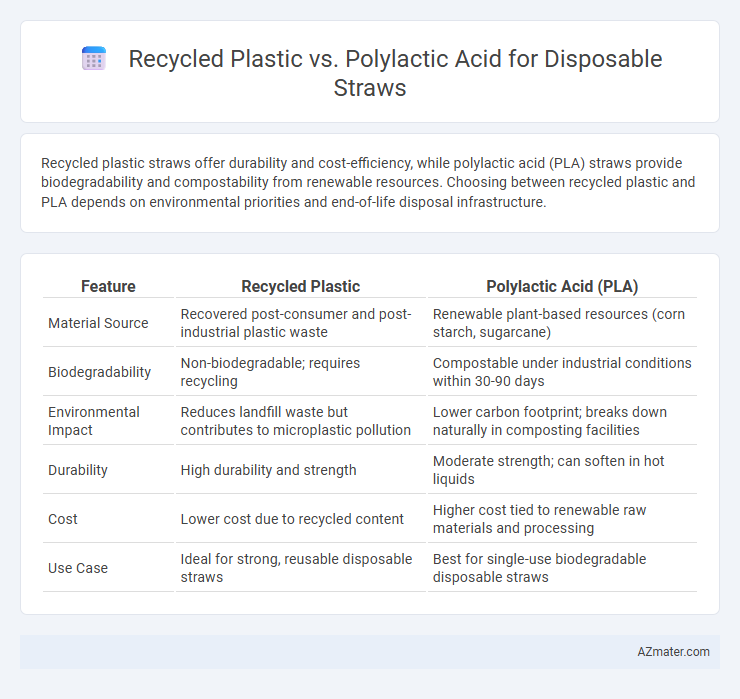Recycled plastic straws offer durability and cost-efficiency, while polylactic acid (PLA) straws provide biodegradability and compostability from renewable resources. Choosing between recycled plastic and PLA depends on environmental priorities and end-of-life disposal infrastructure.
Table of Comparison
| Feature | Recycled Plastic | Polylactic Acid (PLA) |
|---|---|---|
| Material Source | Recovered post-consumer and post-industrial plastic waste | Renewable plant-based resources (corn starch, sugarcane) |
| Biodegradability | Non-biodegradable; requires recycling | Compostable under industrial conditions within 30-90 days |
| Environmental Impact | Reduces landfill waste but contributes to microplastic pollution | Lower carbon footprint; breaks down naturally in composting facilities |
| Durability | High durability and strength | Moderate strength; can soften in hot liquids |
| Cost | Lower cost due to recycled content | Higher cost tied to renewable raw materials and processing |
| Use Case | Ideal for strong, reusable disposable straws | Best for single-use biodegradable disposable straws |
Overview of Disposable Straw Materials
Recycled plastic and polylactic acid (PLA) represent two prominent materials used for disposable straws, each with distinct environmental impacts and performance characteristics. Recycled plastic straws leverage post-consumer plastic waste, reducing landfill contribution but often face challenges in biodegradability and chemical leaching. PLA straws, derived from renewable resources like corn starch, offer compostability under industrial conditions but may require specific disposal infrastructure to fully realize environmental benefits.
What Is Recycled Plastic?
Recycled plastic for disposable straws is made by reprocessing used plastic materials, primarily PET (polyethylene terephthalate) or HDPE (high-density polyethylene), to reduce waste and environmental impact. This material retains much of the durability and flexibility of virgin plastics while lowering carbon emissions through reduced reliance on fossil fuels. In contrast, polylactic acid (PLA) is a biodegradable bioplastic derived from renewable resources like corn starch, offering a compostable alternative that decomposes under industrial composting conditions.
Understanding Polylactic Acid (PLA) Straws
Polylactic acid (PLA) straws are derived from renewable resources such as corn starch or sugarcane, offering a biodegradable alternative to traditional plastic straws made from recycled plastics. Unlike recycled plastic straws, PLA straws decompose under industrial composting conditions, significantly reducing environmental impact and landfill accumulation. However, the effectiveness of PLA straws depends on access to proper composting facilities, as they do not break down efficiently in natural environments compared to the durability and recyclability of recycled plastic straws.
Environmental Impact: Recycled Plastic vs PLA
Recycled plastic straws reduce landfill waste by repurposing existing materials, but they can still contribute to microplastic pollution and often lack biodegradability. Polylactic acid (PLA) straws, derived from renewable resources like corn starch, offer compostability under industrial conditions, significantly lowering long-term environmental footprint. However, PLA production requires agricultural inputs and energy that may offset some ecological benefits, making lifecycle assessment crucial for comparing true sustainability.
Biodegradability and End-of-Life Options
Recycled plastic straws offer limited biodegradability and primarily rely on mechanical recycling processes, which often face contamination challenges and low recycling rates. Polylactic acid (PLA) straws, derived from renewable biomass, exhibit biodegradability under industrial composting conditions, breaking down into water and carbon dioxide within months. End-of-life options for PLA include industrial composting facilities, while recycled plastic straws typically end up in landfills or incineration, contributing to environmental pollution.
Production Processes and Resource Consumption
Recycled plastic straws are produced by reprocessing post-consumer or industrial plastic waste through shredding, washing, and remelting, which significantly reduces raw material demand and energy consumption compared to virgin plastic production. Polylactic acid (PLA) straws are manufactured via fermentation of plant starches like corn or sugarcane into lactic acid, followed by polymerization, involving agricultural inputs, water use, and energy-intensive processing steps. Recycled plastic production generally consumes less water and avoids land use change, while PLA production relies heavily on crop cultivation, impacting resources through fertilizer use and potential competition with food supply.
Performance: Durability and User Experience
Recycled plastic straws offer superior durability, maintaining structural integrity during prolonged use and exposure to liquids, which ensures consistent user experience without deformation. Polylactic acid (PLA) straws, while biodegradable and compostable, tend to soften or lose rigidity when in contact with hot or acidic beverages, potentially compromising user satisfaction. The choice between recycled plastic and PLA straws hinges on balancing performance durability with environmental sustainability preferences.
Cost Comparison: Recycled Plastic vs PLA Straws
Recycled plastic straws typically offer lower production costs than polylactic acid (PLA) straws due to cheaper raw materials and established manufacturing processes, making them more economically viable for large-scale disposable use. PLA straws, derived from renewable resources like cornstarch, often incur higher material and processing expenses, which increases their retail price despite environmental benefits. While recycled plastic straws present cost advantages, decision-making must balance upfront expenses with sustainability goals and market demand for eco-friendly alternatives.
Regulatory and Market Trends
Recycled plastic disposable straws face increasing regulatory restrictions due to environmental concerns, with many governments implementing bans or taxes to reduce single-use plastic waste. Polylactic acid (PLA) straws benefit from favorable market trends driven by growing consumer demand for biodegradable and compostable products, supported by policies promoting sustainable alternatives. Despite PLA's higher cost and composting infrastructure requirements, regulatory incentives and expanding eco-conscious markets accelerate its adoption over traditional recycled plastic straws.
Which Disposable Straw Material Is Better?
Recycled plastic straws offer durability and lower environmental impact by reusing waste materials, reducing landfill contribution compared to virgin plastics. Polylactic acid (PLA) straws, derived from renewable resources like corn starch, provide biodegradability under industrial composting conditions but may not break down effectively in marine environments. Considering lifecycle analysis, recycled plastic straws currently outperform PLA in reducing carbon footprint and waste persistence, making them a more sustainable choice for disposable straws.

Infographic: Recycled plastic vs Polylactic acid for Disposable straw
 azmater.com
azmater.com